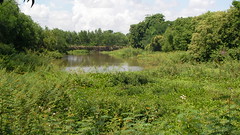Although I’ve arrived back home in Amsterdam, my mind still drifts regularly back to Cambodia. In conversations with friends and day dreams as I ride my bike around town, I think most about the killing fields and that horrible torture prison known as S-21.
It was last friday that Mr. Lee and I set out on the motorscooter for the 25 or so minute ride out to the killing fields of Choeung Ek. Along the way I caught my first long glimpses of the country side, and the boggy farms that dot the landscape. Mr. Lee chimed in “Mr. Mark, you want go firing range and shoot machine gun?” – I tried to control my laughter and calmy replied, no, no, I’m ok, I don’t need shooting range. Noticing my disdain for the question he redirected, “many tourists like, they come and they shoot the guns.”
Eventually we arrive at the killing fields late that morning, on the way in -oddly enough-, greeting someone I met the night before at the Foreign Correspondents Club. Looking past the modest shrine, that I can already see contains many levels of skulls stored behind Plexiglas, I noticed the covered areas of land. Having heard the stories of the mass graves, of the more than 8,000 people that were killed at Choeung Ek, I knew those covered areas where some of the biggest mass graves. Slowly reading and moving past the wooden boards explaining how people were brought to this plot of land from the S-21 prison, to be slaughtered using various types of weapons and methods, I made my way to the covered areas. There in the pit of muddy water and wild grasses, I could see remnants of fabric, the collar of a shirt, perhaps the edge of a pant leg, almost too hard to tell at that point. Eventually I found myself staring at what could only be pieces of bone, somehow still there, sticking up out of the ground. I kept thinking, nooo.. thats not bone. But Iooking again, yes… yes it was; all that was left of some of these thousands of people killed between 1975 and 1979, the year of my birth.
Whether it was walking quietly and slowly through the killing fields, or staring at the floors and walls of the S-21 prison in Phnom Penh, my mind would not stop trying to recreate the sounds and smells of these places in those days. Prisoners being tortured, guards torturing prisoners out of fear of their own lives and that of their families. The muffled screams as prisoners would only be further punished for crying out. The requirement of all prisoners to ask before drinking water or even just going to the bathroom right there in their own tiny cells. All this within rooms that had originally been built and served as places of knowledge, a high school, a place of great hope for the future.
It was nothing short of humbling to see these places. They alone merit the long journey of anyone anywhere in the world who can afford to come; to see, to learn and remember, to visualize what it was like and think about how something like that can happen, just 28 years ago…. my lifetime.
It is easy to say, never again. Yet how often have people been rounded up, tortured, and mass murdered since 1979? Right at this moment, it is happening. THAT is perhaps more disturbing and horrifing than any former prison or field of death – that people are unable or unwilling to mobilize to stop history from repeating itself. Sadly there will be more S-21’s and more Choeung Ek’s in this world. The lone silver lining one could point to, after having also seen how the Cambodian nation is dealing with both the past and present to some extent, is that they have resolved to never repeat that part of history again.

 As I type this entry I’m listening again to a recent episode of CBC radio’s
As I type this entry I’m listening again to a recent episode of CBC radio’s